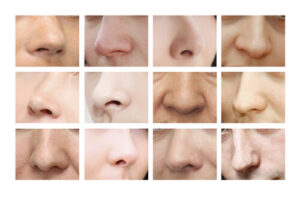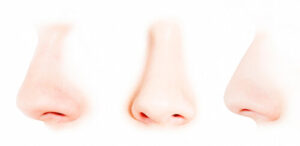The nose types chart by ethnicity provides a fascinating glimpse into the diverse range of human facial features across the globe. As we delve into this intriguing topic, we’ll uncover the distinct characteristics that define various ethnicities, offering more than just a simple classification. This guide invites you to explore our differences’ intricate details and profound beauty, setting the stage for a deeper appreciation of human diversity.
Introduction to Nasal Diversity
Exploring nasal diversity through a ‘nose types chart by ethnicity‘ reveals a rich tapestry of facial features defining human visage across various populations. This fascinating overview provides insights into how nose shapes contribute to our aesthetic identity and connect us to our cultural and genetic heritage.
Roman Nose:
Prominently featured in Caucasian populations, it symbolises strength with its straight nose and prominent bridge.
Greek Nose:
Known for its straightness and narrow appearance, the Greek nose is often considered the epitome of classical beauty, evoking images of ancient sculpture.
African Nose:
This nose shape is characterised by a broader nasal bridge and wider nostrils, is suited to warmer climates, and reflects its genetic heritage.
Asian Nose:
This nose typically has a flatter nasal bridge and a rounder nose tip, mirroring East Asian aesthetic preferences and environmental adaptations.
Button Nose:
This small nose part is universally recognised, often described as cute and playful, and highly sought after in cosmetic nasal surgeries.
Aquiline Nose:
Known as the snub nose or a ‘hawk nose’, it features a slightly curved bridge, adding a distinctive profile valued in various cultures.
Cosmetic Doctors:
Utilise surgical techniques to modify these features, balancing natural appearance with aesthetic desires.
African Descent: Characteristics and Common Shapes
Noses of African descent are diverse, reflecting the wide variety of ethnicities and cultures throughout the African continent. However, there are common characteristics and shapes often associated with this group:
Wide Nasal Bridge: Typically, the noses of African descent have a wider nasal bridge. This characteristic is a distinctive aesthetic feature and relates to genetic adaptations to a hot climate, as a wider nostril opening helps regulate temperature.
Broad Nostrils: The nostrils tend to be broader and more flared, which is thought to aid in better air intake in warm climates and enhance breathing.
Rounded Tip: Compared to other ethnicities, the nasal tip is often rounded and less projected, giving the nose a softer profile.
Low Nasal Bridge: The bridge of the nose might sit lower or appear less pronounced, contributing to a profile that is uniquely flat and broad, distinguishing it from the more elevated bridges seen in Caucasian noses.
Thick Nasal Skin: The skin over the nose is generally thicker and more sebaceous, which can affect the nasal structure’s definition and contours.
These features are celebrated for their natural beauty and are intrinsic to the facial identity of individuals of African descent. In rhinoplasty or nose reshaping, these unique characteristics require specialised techniques to enhance the appearance while respecting and preserving the individual’s ethnic identity.
Asian Descent: Unique Features and Variations

Flatter Nasal Bridge:
Asian noses commonly have a flatter or less pronounced nasal bridge than those of Caucasian or African descent. This trait can contribute to a broader facial profile.
Rounded Nasal Tip:
The nasal tip tends to be less pointed and more rounded, giving the nose a softer appearance. This is often coupled with less cartilage support, influencing the overall nasal shape.
Wide Nostrils:
Similar to those of African descent, Asian noses often feature wider nostrils, but the shape can vary widely across different ethnic groups within Asia.
Thicker Skin:
The skin on the nose is generally thicker and has more sebaceous glands, which can decrease the definition of the nasal tip and other structures. This requires specific consideration in nasal surgeries to achieve a defined outcome.
Lower Projection:
The overall projection of the nose from the face tends to be lower, influencing how pronounced the nose appears to other facial features.
Variability Across Regions:
It’s important to note the diversity within Asian ethnic groups—from East Asia to Southeast Asia and South Asia, each region has distinct nasal characteristics. For example, East Asians typically have the flattest bridges, while South Asians may have a slightly more pronounced bridge and tip definition.
These unique aspects are significant in personal identity and beauty and in clinical approaches to nose jobs like rhinoplasty, where enhancing the nasal features while respecting the patient’s ethnic background is crucial. Surgeons must tailor their techniques to accommodate the structural and aesthetic nuances of Asian noses, ensuring results harmonious with overall facial symmetry and individual expectations.
Caucasian Descent: A Range of Shapes and Sizes

Varied Nasal Bridge:
Caucasian noses typically feature a more pronounced nasal bridge, ranging from high and narrow to more sloped. This variety offers a distinct profile element often highlighted in aesthetic evaluations.
Diverse Nasal Tip:
The nose tip in Caucasian individuals can vary greatly, from pointed and angular to more bulbous or rounded. This diversity allows for a significant degree of individual uniqueness within the population.
Narrow to Medium Nostrils:
Compared to African and Asian descent, Caucasian nostrils tend to be narrower and less flared, though considerable variation exists across individuals.
Tip Projection:
There is often a higher degree of tip projection, which refers to how far the nose extends outward from the face. This feature contributes to the more defined nasal appearance typical in many Caucasians.
Thin to Medium Skin Thickness:
The skin thickness over the nose can vary from thin to medium, which impacts the definition and subtlety of the nasal contour. Thinner skin shows more structural details and imperfections, requiring precise surgical techniques to achieve desired outcomes.
Ethnic and Regional Variations:
Within the Caucasian category are numerous ethnic groups ranging from European to Middle Eastern and North African, each contributing different nasal characteristics. For example, Middle Eastern noses are often characterised by a more pronounced hump on the nasal bridge and a droopier tip compared to Northern European noses, which are typically straighter and more refined.
These varied characteristics make Caucasian noses highly individualistic, with each feature offering a glimpse into this group’s complex genetic and cultural tapestry. Understanding these variations is crucial for achieving results that respect the patient’s ethnic integrity while fulfilling their aesthetic desires in cosmetic and reconstructive nasal surgeries.
Hispanic Descent: Identifying Distinctive Traits

Moderate to Wide Nasal Bridge:
Hispanic noses often feature a moderate to wide nasal bridge, reflecting a blend of diverse genetic influences. This can result in a more pronounced bridge than those of Asian descent but less so than typical Caucasian noses.
Variable Tip Projection:
The projection of the nasal tip can vary widely, with some individuals having a more pronounced tip while others may have a less defined one. This variation adds to the unique facial aesthetics within the Hispanic community.
Broad Nostrils:
Similar to African descent, Hispanic noses can have broader and more flared nostrils, enhancing overall facial harmony and balancing other facial features.
Thicker Skin:
The skin over the nose tends to be thicker and oilier than that of Caucasians, which can sometimes obscure finer nasal details and affect the sharpness of the nasal tip and bridge.
Diverse Nasal Shapes:
Due to the rich mixture of ancestries, Hispanic noses display a wide range of shapes—from straight to slightly curved bridges, from sharply pointed to more bulbous tips. Each nose carries a unique signature that reflects individual heritage.
Strong Tip Definition:
Many Hispanic individuals have a strong, well-defined nasal tip, a distinctive aesthetic feature that adds character and definition to the face.
These traits define the aesthetic contours of Hispanic faces and highlight the complex interplay of genetic heritage that characterises this group. Understanding these features is crucial for aesthetic and reconstructive procedures to ensure beautiful outcomes that respect an individual’s ethnic background.
Middle Eastern Descent: Features and Aesthetic Considerations

Pronounced Nasal Bridge
One of the most notable features is a strong, often prominent nasal bridge that can sometimes include a hump. This characteristic is frequently associated with a classical Middle Eastern profile and is a common focus in rhinoplasty procedures.
Varied Tip Projection
Like other ethnic groups, the degree of nasal tip projection can vary significantly. However, finding a more pronounced tip projection is uncommon, contributing to a more distinctive profile.
Thick Skin
Individuals from Middle Eastern backgrounds often have thicker skin, particularly at the nasal tip and along the nasal bridge. This characteristic can impact the definition and refinement achievable through rhinoplasty, requiring specialised surgical techniques to ensure optimal contouring.
Longer Nasal Length
Compared to other ethnicities, the overall length of the nose may be longer, which influences the overall facial balance and proportions. Adjusting this aspect is often a key consideration in aesthetic procedures.
Wide Nostrils
Nostril size can range from moderate to wide, with a tendency towards more flared nostrils than those seen in Asian or Caucasian noses.
Aesthetic Preferences
In Middle Eastern cultures, there is often a preference for a straighter nasal profile, reducing the prominence of any hump on the nasal bridge and refining the tip to enhance facial harmony.
These features demand a nuanced approach to Rhinoplasty surgery, where the goal is to refine the nose and preserve and enhance the natural ethnic characteristics that define Middle Eastern beauty. Surgeons must consider these aesthetic considerations carefully to achieve results that satisfy their patients’ cultural ideals and individual expectations.
Comparative Analysis Across Ethnicities
A comparative analysis of nasal characteristics across different ethnicities reveals fascinating insights into how genetic, environmental, and cultural factors shape our facial features. Each ethnic group possesses unique nasal features that reflect their evolutionary adaptations and aesthetic preferences. Here’s a breakdown of some distinctive nasal traits observed across various ethnicities:
African Descent:
Africans typically have a wider nasal bridge and nostrils. The nasal tip is often rounded with thicker skin, contributing to less defined nasal contours. These characteristics are considered adaptive for hot climates, allowing for better heat dissipation.
Asian Descent:
Asian noses generally have a flatter nasal bridge and less pronounced nasal tip projection. The nostrils can be wide, and the skin around the nasal area is thicker, leading to softer contours. These features are suited to the humid and temperate climates of many Asian regions.
Caucasian Descent
This group is marked by a wide variety of nasal shapes, often characterised by a more pronounced nasal bridge—sometimes with a dorsal hump—and greater tip projection. The skin tends to be thinner compared to those of African and Asian descent, allowing for more defined nasal features.
Hispanic Descent
Reflecting a blend of Indigenous, African, and European ancestry, Hispanic noses vary widely but commonly include a moderate to wide nasal bridge and variable tip projection. Nostril shapes are diverse, and the skin is typically thicker, like those of African and Asian descent.
Middle Eastern Descent
It often features a pronounced nasal bridge with a possible hump and strong tip projection. The skin is generally thicker, which may reduce the definition of the nasal tip. Aesthetic preferences in this region often lean towards straightening the nasal profile and refining the tip.
Comparing these traits highlights the rich diversity in human facial features, influenced by genetic heritage and the specific environmental conditions each group adapted to over centuries. This diversity underscores the importance of a personalised approach in cosmetic medical procedures like rhinoplasty, where understanding and respecting an individual’s ethnic background is key to achieving natural and culturally congruent results. Such comparative analysis enhances our appreciation for human variation and informs better more respectful medical and aesthetic practices.
Cultural Significance and Perception of Nose Shapes

Symbol of Heritage and Identity
In many cultures, the nose is seen as a marker of ethnic identity, carrying deep ancestral significance. For example, Middle Eastern cultures often celebrate prominent noses as a sign of character and strength. In contrast, a smaller, more refined nose is typically idealised in many Western societies.
Aesthetic Ideals
Cultural preferences for certain nose shapes can strongly influence the popularity of cosmetic medical procedures. In the United States and Europe, rhinoplasty is highly demanded to achieve a ‘Roman’ or ‘refined’ nose, which aligns with classical beauty standards of a straight bridge and a delicate tip. Conversely, in Asian countries, enhancing the nasal bridge and reducing nostril size are common goals aligning with different beauty standards, favouring a more ‘Western‘ appearance.
Cultural Resilience and Change
The globalisation of beauty standards, particularly through media and entertainment, has led to a blending and sometimes clashing of ideals. However, there’s a growing movement towards embracing natural, ethnic-specific features, resisting pressures to conform to a singular beauty standard. This shift is part of a broader cultural conversation about diversity and acceptance.
Professional and Social Perceptions
Studies suggest that certain nose shapes can influence intelligence, social status, and trustworthiness perceptions. Although based on stereotypes, these perceptions can have real-world implications for an individual’s social interactions and professional opportunities.
Artistic and Historical Representation
Throughout history, artists and sculptors have depicted various nose shapes to convey different narratives and traits, from Roman statues with strong, straight noses symbolising power and authority to Renaissance paintings with softer, curved noses conveying beauty and gentility.
Understanding the cultural significance and perception of nose shapes helps us appreciate how deeply interconnected our facial features are with our societal interactions, sense of identity, and aesthetic values. It also underscores the importance of approaching cosmetic enhancements with sensitivity to cultural heritage, ensuring that changes align with an individual’s values and sense of self.
Exploring the ‘nose and types of nose shapes chart by ethnicity‘ enlightens us about the physical characteristics unique to each ethnicity and enriches our understanding of cultural identity and beauty. This journey through the contours of the human nose showcases the exquisite diversity of our species, reminding us that each feature tells a story of heritage and history. As we appreciate these differences, we grow closer to celebrating the unique aspects of every individual worldwide.
If you’re inspired to explore how your unique ethnic background can influence the ideal shape for your nose, or if you’re considering enhancing your natural features with a touch of personalisation, we’re here to help. Call us at (02) 8880 9037 AU Rhinoplasty Sydney, to schedule a consultation and take the first step towards your perfect nose shape and achieving your aesthetic goals with a team that understands and respects the beauty of diversity.
References
The art of ethnic rhinoplasty: A nose job that preserves your cultural identity
https://utswmed.org/medblog/ethnic-rhinoplasty-nose-job/
Identifying the ethnicity of a skull
https://www.futurelearn.com/info/courses/forensic-facial-reconstruction/0/steps/25658
Nose form was shaped by climate | Penn State University
https://www.psu.edu/news/research/story/nose-form-was-shaped-climate/
THE EFFECT OF ETHNICITY ON HUMAN AXILLARY ODORANT
https://www.ncbi.nlm.nih.gov/pmc/articles/PMC4724538/
2020 Plastic Surgery Statistics Report
https://www.plasticsurgery.org/documents/News/Statistics/2020/plastic-surgery-statistics-full-report-2020.pdf


Recent Comments